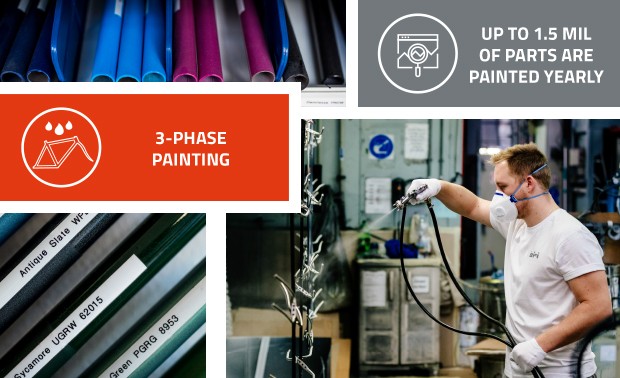Painting of frames and parts
One of the most important departments at BFI is our paint shop. Paint is an essential protective layer for any bike frame and also plays an important aesthetic role. That's why we pay the utmost attention to our painting processes.
The main domain of the paint shop is a conveyor belt that is about 700 metres in length. It moves at a speed of 3.6 metres per minute, which equates to 4.5 hooks per minute. And it's on these hooks that "everything hangs" - one hook can support a frame or eight handlebars.
In our paint shop we use a modern three-layer technology. The first and third layers are powder based, while the second layer is water soluble. The actual process of painting frames and other components involves the following stages:
1. Visual inspection of raw material
Prior to chemical processing, we carry out a thorough visual inspection of the raw material. If we find any minor damage or defects, we remove them immediately, either by mechanical or manual grinding. To ensure a flawless result, if any damage is found during the painting process, we repair the defect and prepare the material for the entire process to be repeated from the beginning.
2. Chemical pre-treatment
This is a crucial process during which we perform six steps to clean steel materials from grease and rust. At the same time, we apply a thin nano-layer of protection to ensure corrosion resistance. At the end of this process, the material is carefully dried to ensure optimum quality and to prepare it for the subsequent painting steps.
3. First paint layer (base coating)
In the first step, the raw material is coated with a layer of base powder paint. Initially, automatic guns are used for spraying in a booth, followed by manual touch-up if necessary and where the part requires it to meet quality standards. The spray guns work on the principle of static electricity, similar to the painting robots. This results in paint savings and uniformity of the coating thickness. We use base coatings in two colors - white and black. In the next step, the component is moved to the oven, where the first paint layer is dried at 150 degrees Celsius.
4. Second layer of water-based paint (colour coating)
In the second stage of the painting process, we apply the first layer of the water-based colour coating. We start by manually touching up the intricate areas that require special attention. This is followed by robotic spraying.
Once this painting phase is complete, the components pass through a drying room where drying takes place. The parts are then baked in an oven at a temperature of 195 degrees Celsius. This successfully completes the second coat of paint and the components are ready for the next steps in the painting process.
5. Applying decals under the final transparent layer
In this step we apply decals to the components underneath the final transparent layer of paint. These decals serve as an aesthetic element and also provide additional protection.
6. Final paint layer (powder coating)
We apply the final layer of powder coating in either a matt or gloss finish. The material is coated with powder paint using an electrostatic process and then baked in an oven at a temperature of 150 to 175 degrees Celsius. Due to this process, the material may appear white when it enters the oven, but after baking in the oven it will regain its original colour and transparency due to the transparent coated surface.
Advantages of painting by BFI
- Environmentally friendly paints
- A wide range of colours to select from
- Decals are protected by transparent powder coating
- Three-phase painting process: base coating, colour coating, final - powder coating





